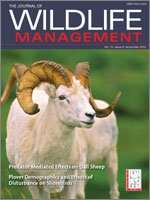Telemetry data have been widely used to quantify wildlife habitat relationships despite the fact that these data are inherently imprecise. All telemetry data have positional error, and failure to account for that error can lead to incorrect predictions of wildlife resource use. Several techniques have been used to account for positional error in wildlife studies. These techniques have been described in the literature, but their ability to accurately characterize wildlife resource use has never been tested. We evaluated the performance of techniques commonly used for incorporating telemetry error into studies of wildlife resource use. Our evaluation was based on imprecise telemetry data (mean telemetry error = 174 m, SD = 130 m) typical of field-based studies. We tested 5 techniques in 10 virtual environments and in one real-world environment for categorical (i.e., habitat types) and continuous (i.e., distances or elevations) rasters. Technique accuracy varied by patch size for the categorical rasters, with higher accuracy as patch size increased. At the smallest patch size (1 ha), the technique that ignores error performed best on categorical data (0.31 and 0.30 accuracy for virtual and real data, respectively); however, as patch size increased the bivariate-weighted technique performed better (0.56 accuracy at patch sizes >31 ha) and achieved complete accuracy (i.e., 1.00 accuracy) at smaller patch sizes (472 ha and 1,522 ha for virtual and real data, respectively) than any other technique. We quantified the accuracy of the continuous covariates using the mean absolute difference (MAD) in covariate value between true and estimated locations. We found that average MAD varied between 104 m (ignore telemetry error) and 140 m (rescale the covariate data) for our continuous covariate surfaces across virtual and real data sets. Techniques that rescale continuous covariate data or use a zonal mean on values within a telemetry error polygon were significantly less accurate than other techniques. Although the technique that ignored telemetry error performed best on categorical rasters with smaller average patch sizes (i.e., ≤31 ha) and on continuous rasters in our study, accuracy was so low that the utility of using point-based approaches for quantifying resource use is questionable when telemetry data are imprecise, particularly for small-patch habitat relationships.
How to translate text using browser tools
1 November 2010
Can We Accurately Characterize Wildlife Resource Use When Telemetry Data Are Imprecise?
Robert A. Montgomery,
Gary J. Roloff,
Jay M. Ver Hoef,
Joshua J. Millspaugh
ACCESS THE FULL ARTICLE
It is not available for individual sale.
This article is only available to subscribers.
It is not available for individual sale.
It is not available for individual sale.

Journal of Wildlife Management
Vol. 74 • No. 8
November 2010
Vol. 74 • No. 8
November 2010
Geographic Information Systems (GIS)
habitat patches
positional error
resource use
telemetry





